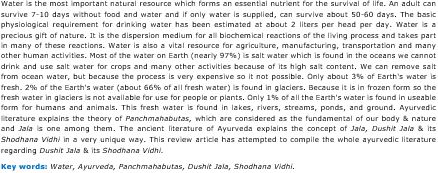Ayurvedic concept of Dushit Jala and its Shodhana Vidhi
Keywords:
Water, Ayurveda, Panchmahabutas, Dushit Jala, Shodhana Vidhi.Abstract
Water is the most important natural resource which forms an essential nutrient for the survival of life. An adult can survive 7-10 days without food and water and if only water is supplied, can survive about 50-60 days. The basic physiological requirement for drinking water has been estimated at about 2 liters per head per day. Water is a precious gift of nature. It is the dispersion medium for all biochemical reactions of the living process and takes part in many of these reactions. Water is also a vital resource for agriculture, manufacturing, transportation and many other human activities. Most of the water on Earth (nearly 97%) is salt water which is found in the oceans we cannot drink and use salt water for crops and many other activities because of its high salt content. We can remove salt from ocean water, but because the process is very expensive so it not possible. Only about 3% of Earth's water is fresh. 2% of the Earth's water (about 66% of all fresh water) is found in glaciers. Because it is in frozen form so the fresh water in glaciers is not available for use for people or plants. Only 1% of all the Earth's water is found in useable form for humans and animals. This fresh water is found in lakes, rivers, streams, ponds, and ground. Ayurvedic literature explains the theory of Panchmahabutas, which are considered as the fundamental of our body & nature and Jala is one among them. The ancient literature of Ayurveda explains the concept of Jala, Dushit Jala & its Shodhana Vidhi in a very unique way. This review article has attempted to compile the whole ayurvedic literature regarding Dushit Jala & its Shodhana Vidhi.
Downloads
References
Sharma PV. Caraka Samhita, Text with English Translation. Chaukhamba Orientalia, Varanasi. Sutrasthana, chapter-27, shlok-215, page:212.
Sharma PV. Caraka Samhita, Text with English Translation. Chaukhamba Orientalia, Varanasi. Vimanasthana, chapter-3, shlok-6, page:315.
Acharya Susruta. Susruta Samhita. edited by Dr. Ambika Dutta Shastri, Chaukhamba Sanskrit Sansthana, Varanasi, reprint:2010, Poorvardha, kalpasthana, chapter-3, shloka-7-8
Acharya Susruta. Susruta samhita, edited by Dr. Ambika Dutta Shastri, Chaukhamba Sanskrit Sansthana, Varanasi, reprint:2010, Poorvardha, Sutrasthana, chapter 45, shloka-15-16
Priyavrata Sharma, Guru Prasad Sharma. Dhanvantri Nighantu. Chaukhmba Orientalia, Varanasi. reprint 1998, Page no 229, shloka no-283-293.
Kaiydeva. Kaiydeva Nighantu (Pathya-apathya Vibhedika) edited by PV Sharma and Guru Prasad Sharma. Chaukhamba Orientalia, Varanasi. second edition: 2006, page no 335.
Prof Gyanendra Pandey, Acharya Bhavamishra. Bhavaprakasha Nighantu. Chaukhamba Bharti Academy, Varanasi. reprint:2004, page no 539.
Narhari Pandit. Raj Nighantu edited by Indradeva Tripathi. Chaukhamba Krishdas Academy, Varanasi. 3rd edition : 2003, page no 285.
Vaidya Shaligram. Shaligram Nighantu. Khemraja Shrikrishnadasa Prakashna, Bombay. Print: II, Page no736.
Priyavrat Sharma. Priya Nighantu. Chaukhamba Subharti Prakashana, Varanasi. print: 2004, page no227.
Om Prakash Verma. Yajurveda. Vaidic Pragya Prakashana, Shaharanpur. first edition:2007.
Acharya Sushruta. Sushruta Samhita, edited by Dr Ambika Dutta Shastri. Chaukhamba Sanskrit Sansthana, Varanasi. reprint:2010, Poorvardha, Sutra Sthana, chapter no-45, shloka no-12,17,18,19.
Acharya Sushruta. Sushruta Samhita, edited by Dr Ambika Dutta Shastri, Chaukhamba Sanskrit Sansthana, Varanasi. reprint:2010, Poorvardha, Kalpasthana, chapter no-3,shloka no-8.
Acharya Vridha Vagbhatta. Astanga Samgraha translated by prof KR Srikantha Murthy. Chaukhamba Orientalia, Varanasi. print :2005, Chapter-6, shloka no 26-27.
Acharya Vridha Vagbhatta. Astanga Samgraha translated by prof KR Srikantha Murthy. Chaukhamba Orientalia, Varanasi. print :2005, Chapter-8, Shloka no 103-104,105-106.
Kaiydeva. Kaiydeva Nighantu (Pathya-apathya vibhedika) edited by PV Sharma and Guru Prasad















